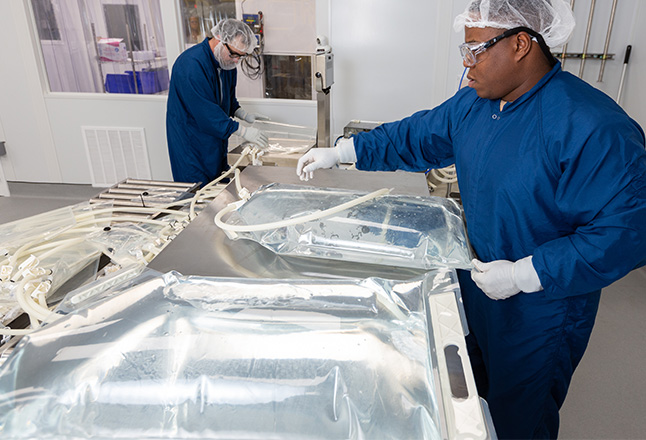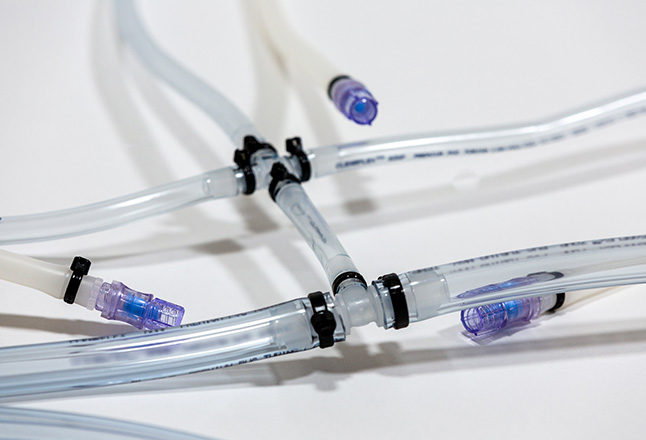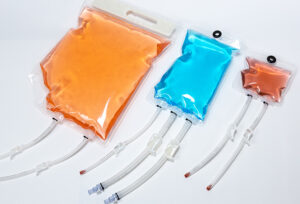
Discover insights from John Litz, Business Development Manager and Specialist in Single-Use Fluid Transfer Applications at ILC Dover, as he delves into the bioprocessing world.
In this Q&A session, John shares his expertise on various topics, including trends in liquid bag adoption, the significance of customization, the impact of industry standards on bag design, and much more.
What trends have you observed regarding the adoption and acceptance of single-use liquid bags and bioprocesses? Are there particular challenges or opportunities associated with this shift?
John Litz: “In bioprocessing, one noticeable trend revolves around the increasing size of batches. Larger batches, such as those using 100-liter or 200-liter bags, are becoming more prevalent, especially in areas focusing on significant scale-ups. This trend extends beyond just the bags themselves; it encompasses various process equipment, including our Fluid Transfer Assemblies (FTAs).

“Size aside, challenges persist in adoption and acceptance. For instance, traditional bottles pose risks such as spillage, a concern that single-use bags mitigate effectively. Losing valuable product due to spillage underscores the importance of robust containment measures.”
“Material choice also plays a crucial role. Ethyl vinyl acetate (EVA) bags can enhance compatibility and performance, while polyethylene offers superior chemical compatibility, flexibility, and durability. To ensure reliability across diverse processes, we conduct rigorous tests—pressure, hanging, weight, leak, and burst—on all our bag options.”
How crucial is customization in meeting the diverse needs of users in the biotherapeutics and cell and gene therapy fields?

JL: “Customization stands as a cornerstone in meeting the diverse needs of users in biotherapeutics and cell and gene therapy. Standard solutions often fall short in accommodating specific requirements, especially in commercial processes. Customization allows tailoring aspects like tubing lengths, connectors, and even bag shapes to optimize processes and maximize product recovery.
“At ILC Dover, we prioritize customization to ensure our partners receive precisely what they need for their processes. This tailored approach enhances efficiency and yields optimal outcomes. Moreover, as a vendor-agnostic company, ILC Dover allows companies to select the best-suited parts or materials from various vendors to meet specific requirements without being constrained by a single supplier.”
How do industry standards, such as USP, impact the design and manufacturing of liquid bags? And how does this contribute to overall regulatory compliance?

JL: “Industry standards, like those set by the USP, significantly influence the design and manufacturing of liquid bags. Compliance with regulations such as USP, FDA, and ISO is paramount, especially concerning materials in contact with the product. For instance, our use of Renolit 9101 polyethylene film as a product contact material aligns with stringent regulatory requirements, ensuring biocompatibility and product integrity. Compliance extends to tests like BPOG and USP 665 extractables, which are crucial for assessing material safety and preventing contamination. Adhering to these standards not only ensures regulatory compliance but also bolsters overall product reliability and safety.”
What are the common challenges that pharmaceutical professionals face when selecting and using liquid bags, and how does ILC Dover address them?
JL: “Pharmaceutical professionals often encounter challenges in finding suitable products that seamlessly integrate into their processes.”

“At ILC Dover, we tackle these challenges head-on through customization. By working closely with our customers, we ensure that specific needs, such as tubing length or connector type, are met. Additionally, our experienced team provides expertise across various applications, aiding users in optimizing their processes effectively. Material compatibility concerns are addressed through meticulous selection, guaranteeing the suitability of our products for diverse applications. Our vendor-agnostic capabilities ensure flexibility and compatibility across various systems, ultimately providing tailored solutions that seamlessly integrate into our clients’ processes.”
“Moreover, ensuring regulatory compliance is a priority, with our products meeting the necessary certifications for different markets and applications.”
How important is speed and flexibility in the supply chain for companies engaged in biotherapeutics and cell and gene therapy?
JL: “Speed and flexibility are paramount in the supply chain for companies involved in biotherapeutics and cell and gene therapy. While quality and regulatory compliance are crucial, speed and flexibility are vital for maintaining a seamless manufacturing process and preventing disruptions. The ability to respond quickly to changing needs and circumstances, whether in fulfilling orders or adapting to design changes, is essential for ensuring consistent production and meeting tight timelines. Flexibility allows for agile responses to evolving requirements, ultimately contributing to the overall efficiency and success of the biotherapeutics supply chain.”
Can you elaborate on the specific advantages of single-use liquid bags at various stages of bioprocessing?
JL: “Single-use liquid bags offer several advantages throughout the stages of bioprocessing. These bags provide unmatched flexibility, allowing for easy scale-up from small volumes in upstream processes to larger volumes in downstream purification. Unlike traditional bottles, bags are more adaptable to different storage and transportation methods, simplifying logistics and minimizing the risk of spills or breakage.”
“Moreover, the use of single-use bags reduces contamination risks and eliminates the need for sterilization, streamlining processes and ensuring product integrity. Whether it is optimizing space utilization, facilitating scale-up, or enhancing sterility, single-use liquid bags offer unparalleled advantages across the bioprocessing continuum.”
How do manufacturers ensure the integrity and safety of liquid bags?
JL: “Manufacturers ensure the integrity and safety of liquid bags through rigorous quality assurance measures and comprehensive testing protocols, which are detailed in our product validation guides. Inspections are conducted meticulously to detect any defects or contaminants, safeguarding the purity of the therapeutic product. Various tests, including hang tests, burst testing, and pressure testing, assess the durability and reliability of the bags under different conditions.”
“By adhering to stringent quality standards and continuously improving manufacturing processes, manufacturers uphold the integrity and safety of liquid bags, ensuring they meet the highest quality and safety requirements demanded by the bioprocessing industry.”
Where do you see the future of liquid bags for fluid storage and transfer heading? Are there emerging trends or technologies to watch?
JL: “Advancements in scale and versatility characterize the future of liquid bags for fluid storage and transfer. Emerging trends indicate a shift towards larger-scale manufacturing, with single-use bioreactor bags accommodating volumes ranging from 2,000 to 6,000 liters. Concurrently, there is a growing demand for smaller, more specialized bags tailored for applications such as autologous cell and gene therapies. These trends reflect the industry’s evolving needs for scalability and adaptability.”
“Additionally, ongoing innovations in materials and manufacturing processes are poised to enhance the performance and reliability of liquid bags further. As the industry continues to evolve, liquid bags will remain indispensable for fluid storage and transfer, offering unmatched convenience, efficiency, and reliability across diverse bioprocessing applications.”
Navigating the intricacies of bioprocessing demands tailored, single-use liquid bag solutions and unwavering commitment to quality and compliance. Contact us to discuss your unique application today.

